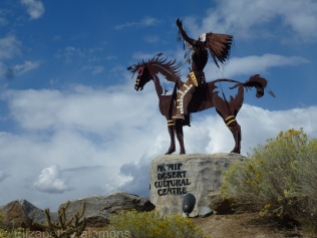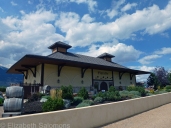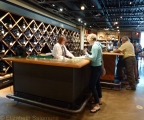The Okanagan

When I was growing up in Edmonton, I knew the Okanagan as the place where Albertans headed to every summer in droves. It was considered the perfect family vacation destination by the parents of my school friends, who went there every summer and came back with stories of long days spent swimming and boating in lakes. (My family went to the mountains instead ― a choice my parents made that I personally had no issues with.)
Nowadays, the Okanagan is still a popular summer lake district, but that dry, sunny, Mediterranean-like climate that makes it so popular with boaters and swimmers is also what makes the region perfectly suited to growing grapes.

Those grapes get harvested in the fall, and this year the Okanagan had a bumper crop. While setting a record for the earliest start of harvest ever (August 12) ― thanks to a hot and dry spring and summer ― this year’s grapes were smaller than usual. That’s not necessarily a bad thing. Smaller grapes mean less product, but it can also mean a higher quality wine because the flavour and colour is concentrated.
Fall is also wine festival time. If you happened to be in the Okanagan earlier this month, you could have participated in some of the 125 events that make up the Fall Okanagan Wine Festival with 20,000 of your closest wine-loving friends. This year was the festival’s 35th anniversary.
Yup. That’s 35 years of wine festivalling. But it might surprise you to learn that the tradition of winemaking in the Okanagan goes back to before the birth of Canada. The first person to plant grapes in the Okanagan was Father Charles Pandosy, a Catholic missionary who came to the area in 1859. He needed wine, as all priests do, to be able to administer Mass, and so he planted himself a vineyard.
The first commercial winery ― Calona Vineyards ― was established in Kelowna in 1932 and is still in business. In 1968, Nk’Mip (in-ka-meep) Cellars was established in Osoyoos. Fourteen years later, there were 14 wineries operating in the Okanagan.
And the quality of Okanagan wine back in the 1980s? Well, let’s be generous and call it plonk.
Then along came free trade. It turns out that the Free Trade Agreement of 1988 was the best thing to happen to BC’s wine industry. After losing their preferred status in BC liquor stores, Okanagan winemakers knew they had to improve their product ― fast ― if they were going to complete on the world stage of vintners. So what did they do? They pulled up two-thirds of their vines and replanted with vines that produced better quality grapes suitable for making premium quality wine.

And here’s the amazing thing: the BC winemaking industry exploded. There were 17 wineries in 1990; by 1994, that number had doubled. It doubled again by 2000 and again by 2008. As of last year, there were 254 wineries in operation in the Okanagan with 10,259 acres of vines planted. (To be honest, the rapid expansion of vineyards is beginning to threaten BC’s fruit industry because long-time fruit growers are pulling up their orchards to plant vines. They know they can earn far more from growing grapes than they can from growing peaches and cherries.)
The awards started pouring in early on. The first big one was the 1994 Avery Trophy for Best Chardonnay in the World at London’s International Wine and Spirit Competition, awarded to Kelowna’s Mission Hill Winery. At the 2014 Decanter World Wine Awards (the world’s biggest competition with over 15,000 wines entered in 2014), Okanagan wineries took home 105 medals, including three regional trophies and four gold medals. (By comparison, Californian wineries took home 83 medals that year, none of which were trophies or gold medals.)
Okanagan wines are rather pricey ― some would argue overpriced ― for what you get. But here’s what I’ve learned: those high prices are due to the cost of labour and land. BC vineyard land is the most expensive in the world after Europe. And so, here’s a pro-tip: if you are on a budget, stick to the older Okanagan wineries for more affordable wines. They aren’t cheaper because the wines are lower quality ― they’re cheaper because those wineries bought land back in the 1990s before it got crazy expensive. Their overhead is much lower.
The Okanagan is divided into five subregions: Kelowna, Naramata Bench, Okanagan Falls, Golden Mile, and Black Sage Bench/Osoyoos. I made it to four of these subregions last summer on my way home from Alberta. Here’s a look at some of the wineries I got to. (Click on the first photo at top left to open up the slide show.)
In all, I visited nine wineries and did seven tastings over two days, starting in Osoyoos and finishing 120 km to the north in West Kelowna. I didn’t bother doing a tasting at either Quail’s Gate or Mission Hill ― their wines are readily available in Vancouver, and both tasting rooms, though impressive, were a bit of a zoo. I expected that, because the larger wineries attract the largest crowds, but I stopped at them anyways because I’d been told both were impressive operations and worth a look-see.
But here’s another pro-tip: the best wine-tasting experiences are to be had at the smallest of wineries. Serendipity, for example, is a place that holds up to its name. The tasting room is simple and unpretentious ― a cordoned-off end of a storage shed ― but I had the complete and undivided attention of the wine seller. That experience was wine-buying at its most fun.
Another winery worth a stop is Pentâge Winery on the Naramata Bench. I stopped here on the recommendation of my brother, who claimed it made the best Cabernet Franc he’d ever tasted. A stop at this winery involves a long, windy drive up the side of the mountain, and then a long, steep, windy ride down the side of the mountain that probably scares off timid and cautious drivers. In fact, the winemaker admitted that some visitors won’t even attempt the driveway and instead park their car up top and walk down. I found the tasting room at Pentâge a most pleasant oasis and, knowing it was going to be my last stop of the day, I took my time and chatted with the winemaker for a long while. That stop was the highlight of my two days of wine tasting. (Sadly, my camera was acting up and all my photos are out of focus.)
I won’t have the ways and means to do an Okanagan trip every summer, but I do know this: my wine-buying trip of this past summer has certainly opened my eyes to the best way to buy wine.












